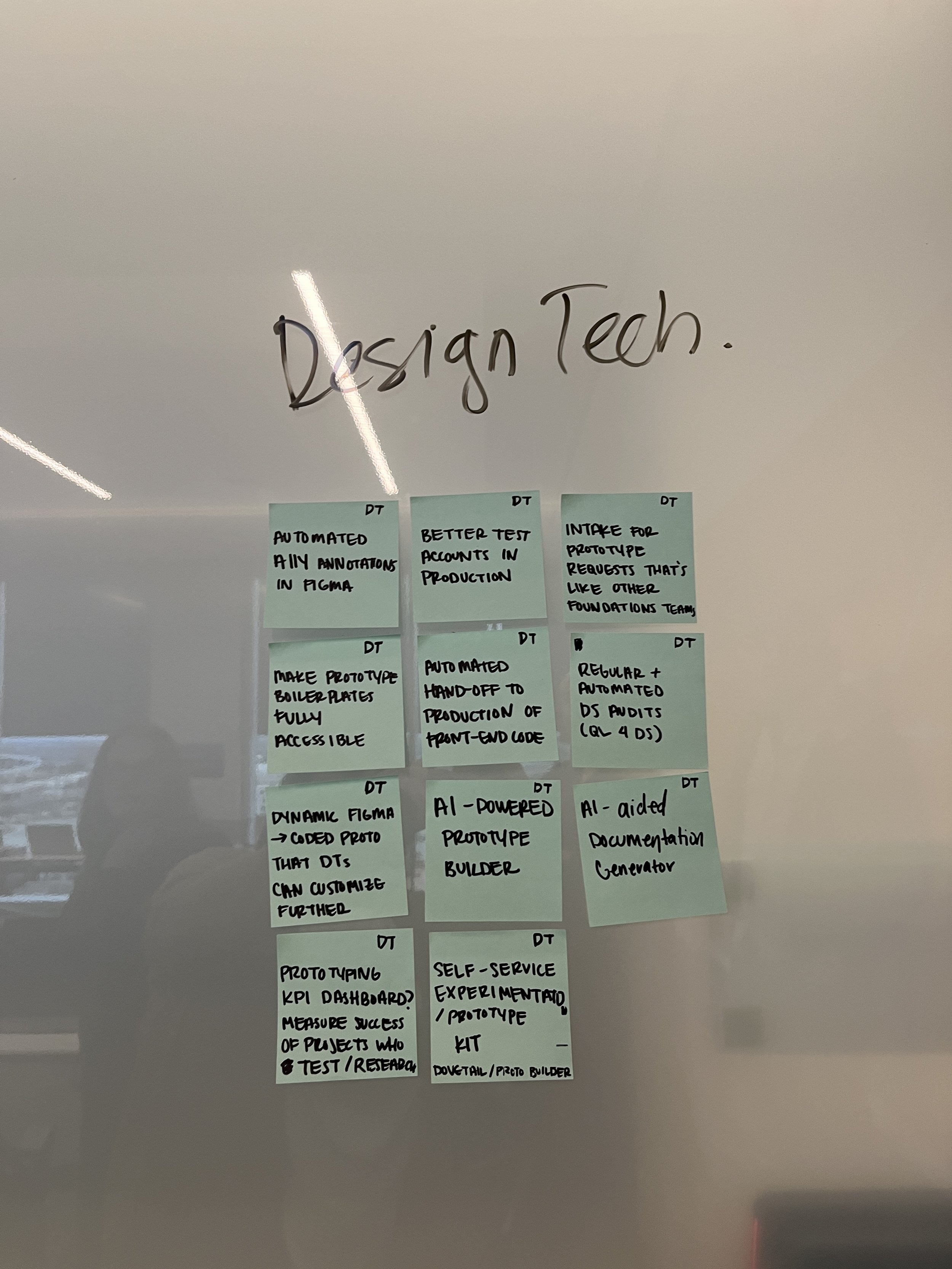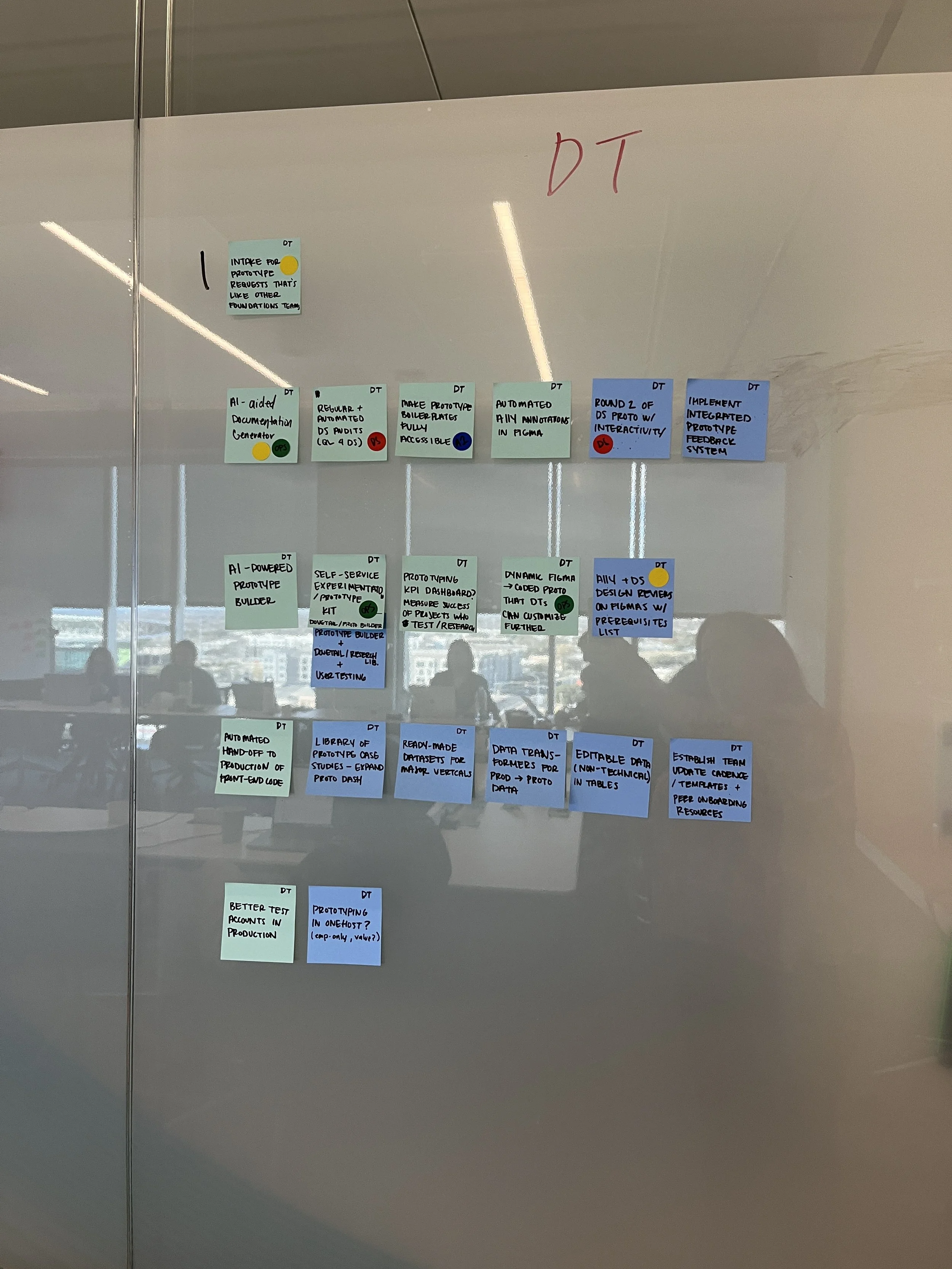Summary
Role: UX Operations Manager leading strategic initiatives
Team: 9 leaders across 5 sub-teams (~30 people total)
Tools: Figma, FigJam, Claude, Gemini
Methods: Strategic Planning, Design Thinking, AI-enhanced workflows, Facilitation
Key Takeaways:
AI technology enhanced human collaboration rather than replacing it
Building exercises sequentially created momentum and coherence
Impact:
First-ever annual strategy completed before fiscal year start
Strategy development time reduced from months to weeks
100% leader buy-in with minimal revisions needed
Established repeatable framework for future planning
“Amy set a high bar for how collaborative strategy development should work.”
The Challenge
When Indeed's newly formed UX Foundations team brought together five previously independent sub-teams—Accessibility, Design Systems, Design Technology, Research Operations, and UX Operations—we faced a critical challenge: how to align 30+ professionals who had never worked together around a unified vision and annual strategy.
Problems to solve:
No established collaboration rituals between sub-teams
Historical pattern of starting fiscal years without completed strategies
Limited time and budget for traditional months-long planning processes
Need to balance individual team autonomy with collective vision
Approach
Onsite Planning: Defining the landscape progressively before designing the solution
I designed a two-day onsite structure that would generate all inputs needed for our annual strategy while fostering the team connections we desperately needed. The structured agenda moved teams from big-picture strategy down to actionable focus areas through defining foundational elements that built on each other over the course of two days.
We started by understanding each other’s teams and day-to-day functions, building empathy and understanding between our new consolidated team. With that in mind, we co-created team values and a team vision—both exercises that previously could have taken days but the workshop structure plus AI tools reduced that down to hours.
With a better understanding of our team, we were able to brainstorm challenges and approaches, defining a roadmap for FY2025 that would influence our annual planning. Each team identified opportunities to support others at each phase of the roadmap build to reduce redundancy and leverage previous experience.
Key decisions:
Progressive information architecture: Each exercise would build on the previous one, from discovery → synthesis → planning
AI integration: Strategically use LLMs to compress traditionally long exercises (like vision setting) from days to hours
Collaborative ownership: Distribute facilitation across leaders to build buy-in and showcase diverse expertise
Partnerships:
Finance: Secured budget approval through data-driven business case
Senior Team Leaders: Gained buy-in by demonstrating thoughtful workshop progression and planning
Team Leaders: Provided clear frameworks and pre-populated drafts, and proactively checked in to ensure success
Image 1. Agenda for Onsite Day 1, showing progressive exercises
Image 2. Design Technology’s strategy items
Image 3. Design Technology’s roadmap with collaboration opportunities with other teams marked with colored dots
Annual Strategy Creation: Pioneering an innovative approach using AI-enhanced workflows
After the onsite, I co-created a comprehensive strategy document in partnership with LLMs:
Data Extraction: Converted 100+ sticky notes from roadmap exercise into structured data using AI
Synthesis: Combined roadmap items + team vision + values into comprehensive prompt
Generation: Partnered with AI to create the initial strategy draft with team-specific sections
Validation: Cross-referenced and validated the content with recent community data
I shared this draft with the team, and team members remarked how shockingly accurate the draft was and how helpful it was to have something to start with. I also provided a process document, including a timeline with clear deadlines and actions to guide the team through revisions and reviews. The resulting strategy was delivered on time, well ahead of the start of the fiscal year, and will be shared with UX leadership to better understand our new team, and will define quarterly planning throughout FY2025.
“Amy never left anyone starting from scratch...her support was thoughtful, consistent, and incredibly effective.”
Results & Impact
Quantitative Outcomes
100% on-time delivery: First annual strategy completed before fiscal year
Qualitative Impact
Draft accuracy: AI-generated content required minimal revisions
Cultural shift: "I've never been on a team at Indeed that was so ahead of schedule with FY planning" - Team Leader
Team cohesion: Successfully made newer team members feel "included and valued" through thoughtful facilitation
Reduced cognitive load: Leaders reported AI-generated drafts "saved a huge amount of time" and were "highly relevant"
Reflection
This project exemplifies my ability to bridge strategy, operations, and innovation. By combining human-centered facilitation with AI capabilities, we achieved what previously seemed impossible: team cohesion and comprehensive planning in compressed timelines without sacrificing quality.


